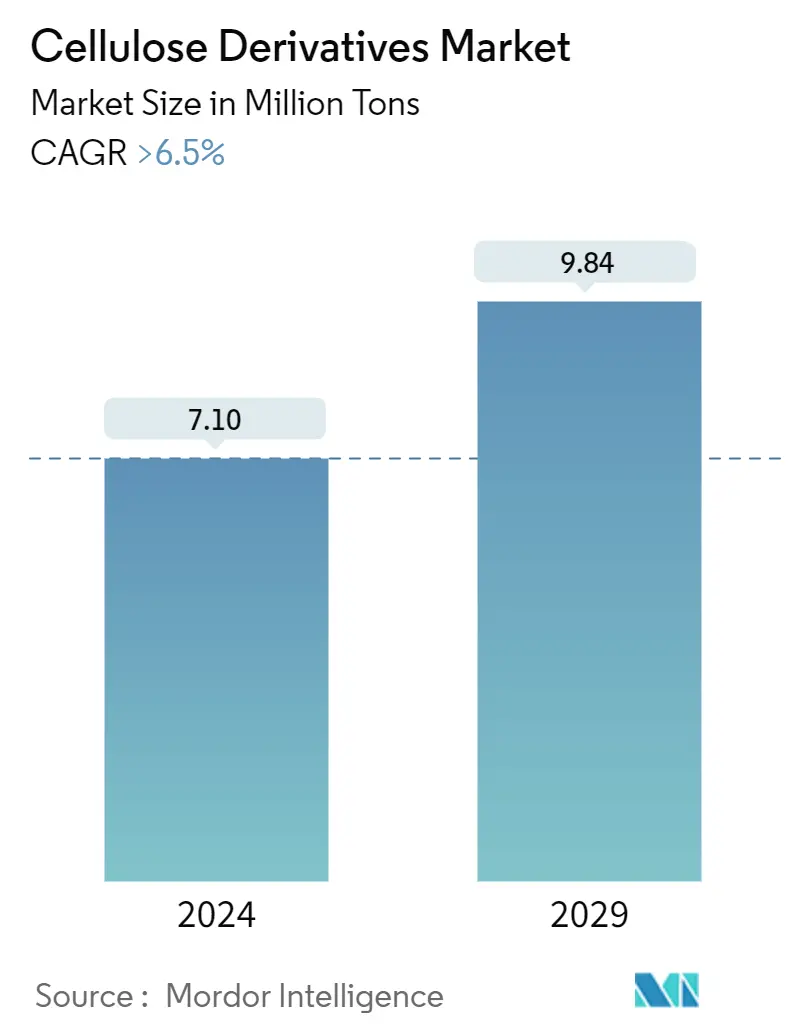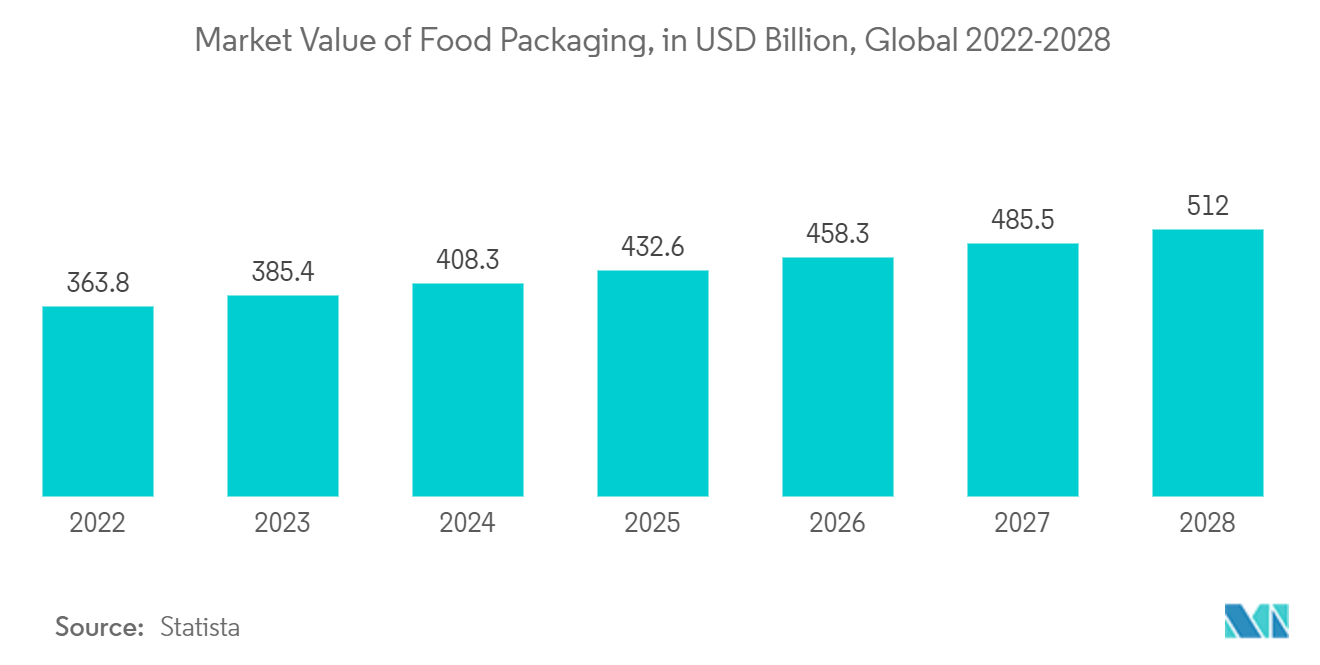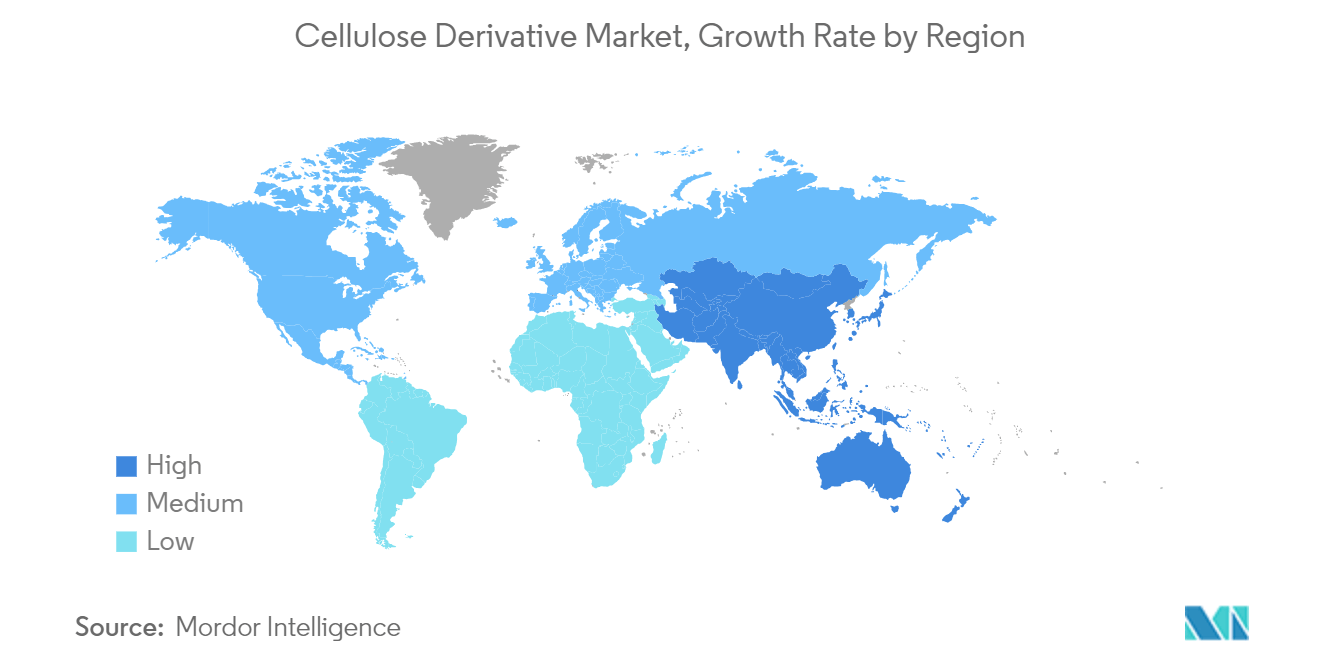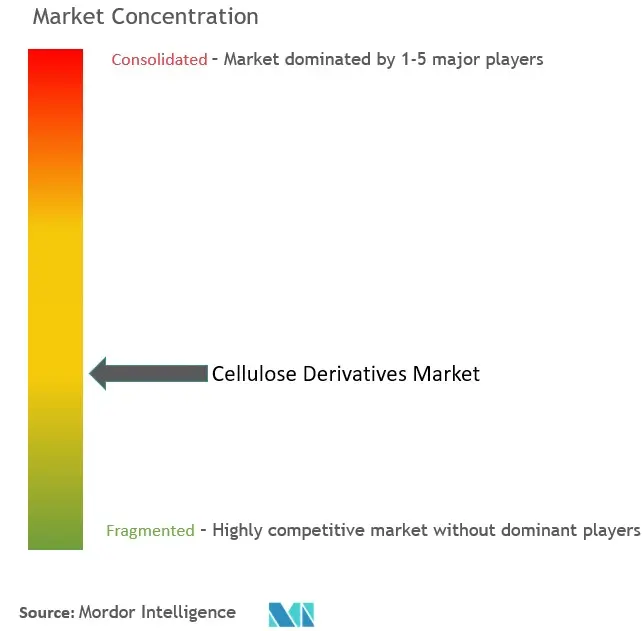Cellulose Derivatives Market Size

| Study Period | 2019 - 2029 |
| Base Year For Estimation | 2023 |
| CAGR (2024 - 2029) | 6.50 % |
| Fastest Growing Market | Asia Pacific |
| Largest Market | Asia Pacific |
| Market Concentration | Low |
Major Players
*Disclaimer: Major Players sorted in no particular order |
Cellulose Derivatives Market Analysis
The Cellulose Derivatives Market size is estimated at 7.10 Million tons in 2024, and is expected to reach 9.84 Million tons by 2029, growing at a CAGR of greater than 6.5% during the forecast period (2024-2029).
The cellulose derivatives market was negatively impacted, and its growth and stability were hindered by the spread of the COVID-19 pandemic worldwide in 2020. Governments across the world imposed specific parameters and regulations, which caused the market to experience challenges such as the unavailability of raw materials, transportation limitations, and a reduced workforce. Further, as countries worldwide started to work on recovering their socioeconomic state in 2021, the market also started to witness recovery and growth due to rising investment and other business activities across the end-user industries.
Major factors driving the market studied are the increasing demands from the pharmaceutical industry and the growing use of cellulose ether in the building and construction industry.
The major hindrance to this market is the competition for regenerated cellulose fibers from synthetic fibers and other protein-based fibers. Manufacturers often prefer switching toward inexpensive synthetic materials, like polyester, to cut down their production costs. In addition, synthetic fibers possess superior characteristics of adaptability, durability, elasticity, and strength equal to that of VSF, making it a suitable choice for manufacturers.
The innovation of biofuels as a promising renewable energy source through the use of cellulose is a significant opportunity for the growth of the market.
Asia-Pacific accounted for the highest market share, and the region is also likely to dominate the market during the forecast period.
Cellulose Derivatives Market Trends
Food and Beverage Industry to Dominate the Market
- Methylcellulose, hydroxypropyl cellulose, and carboxymethyl cellulose, among others, are the cellulose derivatives that are being extensively used to produce films owing to their suitable chemical and mechanical properties. Cellulose alone or with other matrixes has been employed in food packaging applications.
- Cellulose ether is odorless, tasteless, non-toxic, easily soluble, and can be stored for a long period of time. Furthermore, it has a high viscosity and strong shape-preserving capacity, all of which make it a preferred choice for the food and beverage industry.
- In the food and beverage industry, cellulose ether is used as an extender of adhesive agent in the process of jam, sugar, fruit syrup, and pungent sauce. It is also used in various dessert preparations as it enables the tissue to be homogeneous and fine, thereby making the appearance of the dessert beautiful.
- Other applications include a stabilizing agent for the production of ice cream, a fixing agent in the production of lemon and grape drinks, semi-fluid edible oil, as a film-forming agent in the surface treatment of vegetables, fruit, eggs, and tea leaves to keep the original color and flavor for long, etc.
- Moreover, the food packaging market will significantly support the growth in demand for cellulose derivatives worldwide. The underlying reason for the increase in food packaging is the increase of focus on food safety, promotion and higher value among consumers, and higher shelf life of food items in the growing urban lifestyle worldwide. The consumption of fast food is projected to keep growing, and the demand for ready-to-eat food products and convenience food will also likely grow because of the hectic lifestyles and growing disposable income of people globally.
- According to the All India Food Processors Association, the Indian food and beverage packaging industry is growing exponentially year-on-year and is expected to reach USD 86 billion in 2029, following rapid urbanization, rising disposable incomes, and evolving consumption patterns.
- As per the latest data from the Barbecue Lab, 83% of families in the United States eat at fast food restaurants at least once a week, and about 45% of the people of age group 20-39 residing in the country eat fast food on any given day.

Asia-Pacific Region to Dominate the Market
- Asia-Pacific is the largest market in cellulose derivatives, with market segments like the textile industry, cosmetics, and pharmaceuticals growing in the coming years. Moreover, the increasing penetration of the manufacturing base in Asian countries is expected to support the growth.
- China's textiles, apparel, and clothing accessories export was worth USD 323.344 billion in 2022, a growth of 2.53% over the previous year. According to the World Trade Organization (WTO), in terms of share in world textile exports in 2022, China remained a global leader, with a share of around 31.7%. With the increase in textile production, the cellulose market is expected to register a gradual growth in China.
- The Indian textile sector is one of the oldest industries in the Indian economy, dating back several centuries. According to Invest India, the Indian textile and apparel market size was estimated to be around USD 165 billion in 2022, with the domestic market constituting USD 125 billion and exports contributing USD 40 billion.
- Construction is also a significant end-user industry for the cellulose derivatives market due to its use in construction materials such as adhesive, mortars, and cement, among others, for property enhancement applications. Asia-Pacific is the largest producer of such construction materials. For instance, according to the US Geological Survey, in 2022, China, India, and Vietnam were the largest cement producers globally.
- Moreover, cellulose derivatives are extensively utilized in the Paper end-user industry for the production of paper, cardboard, and paperboard products. Asia-Pacific is among the largest producers of such products globally, making it a significant consumer of cellulose derivatives. For instance, according to the Food and Agriculture Organization (FAO), in 2022, China, Japan, India, Indonesia, and South Korea were among the top 10 producers of paper and paperboard.
- It is also expected to be the fastest-growing market during the forecast period, with increasing demand for segments like the textile, food & beverage industries in China, India, and the ASEAN countries. Moreover, the established cosmetic industry in Japan and South Korea is also contributing to the growth of cellulose derivatives.

Cellulose Derivatives Industry Overview
The global cellulose derivatives market is partially fragmented, with many competitors. The major companies (not in any particular order) include Daicel Corporation, Ashland, Eastman Chemical Company, Shin-Etsu Chemical Co. Ltd., and Dow, among others.
Cellulose Derivatives Market Leaders
-
Ashland
-
Daicel Corporation
-
Eastman Chemical Company
-
Shin-Etsu Chemical Co., Ltd
-
Dow
*Disclaimer: Major Players sorted in no particular order

Cellulose Derivatives Market News
October 2023: Ashland announced the next generation of modified methyl cellulose derivatives, Culminal GAP (Green Aware Performance), for premium cement adhesives. Culminal GAP (Green Aware Performance) is a high-performing cellulose ether used in cementitious-based systems.
Cellulose Derivatives Market Report - Table of Contents
1. INTRODUCTION
- 1.1 Study Assumptions
- 1.2 Scope of the Study
2. RESEARCH METHODOLOGY
3. EXECUTIVE SUMMARY
4. MARKET DYNAMICS
-
4.1 Drivers
- 4.1.1 Increasing Demand from Pharmaceutical Industry
- 4.1.2 Increasing Use of Cellulose Ether in Building and Construction Industry
- 4.1.3 Other Drivers
-
4.2 Restraints
- 4.2.1 Competition of Regenerated Cellulose Fibers from Synthetic Fibers and Other Protein-based Fibers
- 4.2.2 Other Restraints
- 4.3 Industry Value-Chain Analysis
-
4.4 Porter's Five Forces Analysis
- 4.4.1 Bargaining Power of Suppliers
- 4.4.2 Bargaining Power of Consumers
- 4.4.3 Threat of New Entrants
- 4.4.4 Threat of Substitute Products and Services
- 4.4.5 Degree of Competition
- 4.5 Technological Snapshot
- 4.6 Feedstock Analysis
5. MARKET SEGMENTATION (Market Size in Value/Volume)
-
5.1 Chemical Type
- 5.1.1 Cellulose Esters
- 5.1.2 Cellulose Ethers
- 5.1.3 Regenerated Cellulose
-
5.2 End-user Industry
- 5.2.1 Construction
- 5.2.2 Cosmetics & Pharmaceuricals
- 5.2.3 Food & Beverage
- 5.2.4 Paints & Coatings
- 5.2.5 Plastics
- 5.2.6 Textile
- 5.2.7 Other End-user Industries
-
5.3 Geography
- 5.3.1 Asia-Pacific
- 5.3.1.1 China
- 5.3.1.2 India
- 5.3.1.3 Japan
- 5.3.1.4 South Korea
- 5.3.1.5 Rest of Asia-Pacific
- 5.3.2 North America
- 5.3.2.1 United States
- 5.3.2.2 Mexico
- 5.3.2.3 Canada
- 5.3.3 Europe
- 5.3.3.1 Germany
- 5.3.3.2 United Kingdom
- 5.3.3.3 Italy
- 5.3.3.4 France
- 5.3.3.5 Rest of Europe
- 5.3.4 Rest of the World
- 5.3.4.1 South America
- 5.3.4.2 Middle East & Africa
6. COMPETITIVE LANDSCAPE
- 6.1 Mergers & Acquisitions, Joint Ventures, Collaborations, and Agreements
- 6.2 Market Share/Ranking Analysis**
- 6.3 Strategies Adopted by Leading Players
-
6.4 Company Profiles
- 6.4.1 Ashland
- 6.4.2 Celanese Corporation
- 6.4.3 Cerdia International GmbH
- 6.4.4 Dow
- 6.4.5 Daicel Corporation
- 6.4.6 DuPont
- 6.4.7 Eastman Chemical Company
- 6.4.8 FKuR
- 6.4.9 Futamura Chemical Co. Ltd
- 6.4.10 Grasim (Aditya Birla Group)
- 6.4.11 Lenzing AG
- 6.4.12 Mitsubishi Chemical Corporation
- 6.4.13 Nouryon
- 6.4.14 Sappi Limited
- 6.4.15 Shin-Etsu Chemical Co. Ltd.
- 6.4.16 Xinjiang Zhongtai Chemical Co. Ltd
- *List Not Exhaustive
7. MARKET OPPORTUNITIES AND FUTURE TRENDS
- 7.1 Biofuel innovation through cellulose
- 7.2 Other Opportunities
Cellulose Derivatives Industry Segmentation
Cellulose derivatives are formed from the pulp produced after the separation of cellulose fibers from fiber crops, waste paper, or wood. Cellulose is a natural polymer and the most abundant polysaccharide that can be extracted from a vast number of sources, including wood and plants, some bacteria and algae, and also tunicates. Cellulose derivatives are extensively used in various industrial sectors, such as paint and coatings, textiles, food and beverage, etc.
The market is segmented by product type (cellulose esters, cellulose ethers, and regenerated cellulose), end-user industry (construction, cosmetics, and pharmaceuticals, food and beverage, paints and coatings, plastics, and textiles), and geography (Asia-Pacific, North America, Europe, and the Rest of the World). The report also covers the market size and forecasts for the market in 11 countries across the globe.
The report offers market size and forecasts for the cellulose derivatives market in volume (tons) for all the above segments.
| Chemical Type | Cellulose Esters | |
| Cellulose Ethers | ||
| Regenerated Cellulose | ||
| End-user Industry | Construction | |
| Cosmetics & Pharmaceuricals | ||
| Food & Beverage | ||
| Paints & Coatings | ||
| Plastics | ||
| Textile | ||
| Other End-user Industries | ||
| Geography | Asia-Pacific | China |
| India | ||
| Japan | ||
| South Korea | ||
| Rest of Asia-Pacific | ||
| Geography | North America | United States |
| Mexico | ||
| Canada | ||
| Geography | Europe | Germany |
| United Kingdom | ||
| Italy | ||
| France | ||
| Rest of Europe | ||
| Geography | Rest of the World | South America |
| Middle East & Africa |
Cellulose Derivatives Market Research FAQs
How big is the Cellulose Derivatives Market?
The Cellulose Derivatives Market size is expected to reach 7.10 million tons in 2024 and grow at a CAGR of greater than 6.5% to reach 9.84 million tons by 2029.
What is the current Cellulose Derivatives Market size?
In 2024, the Cellulose Derivatives Market size is expected to reach 7.10 million tons.
Who are the key players in Cellulose Derivatives Market?
Ashland, Daicel Corporation, Eastman Chemical Company, Shin-Etsu Chemical Co., Ltd and Dow are the major companies operating in the Cellulose Derivatives Market.
Which is the fastest growing region in Cellulose Derivatives Market?
Asia Pacific is estimated to grow at the highest CAGR over the forecast period (2024-2029).
Which region has the biggest share in Cellulose Derivatives Market?
In 2024, the Asia Pacific accounts for the largest market share in Cellulose Derivatives Market.
What years does this Cellulose Derivatives Market cover, and what was the market size in 2023?
In 2023, the Cellulose Derivatives Market size was estimated at 6.64 million tons. The report covers the Cellulose Derivatives Market historical market size for years: 2019, 2020, 2021, 2022 and 2023. The report also forecasts the Cellulose Derivatives Market size for years: 2024, 2025, 2026, 2027, 2028 and 2029.
Cellulose Derivatives Industry Report
Statistics for the 2024 Cellulose Derivatives market share, size and revenue growth rate, created by Mordor Intelligence™ Industry Reports. Cellulose Derivatives analysis includes a market forecast outlook 2029 and historical overview. Get a sample of this industry analysis as a free report PDF download.



